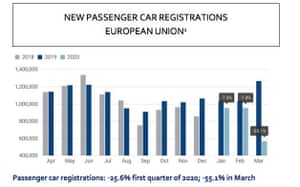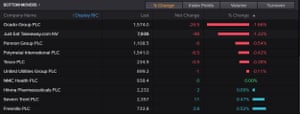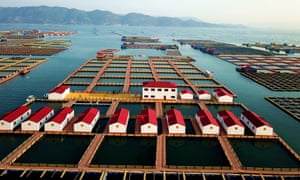The stock market rally is set to continue stateside, with futures pointing to gains on Wall Street:
- Dow futures are up +2.7%
- S&P 500 futures are up +2.4%
- Nasdaq futures are up +1.8%
Updated
Investors poised for China rate cut after Q1 GDP plunge
There’s a growing expectation that China will cut its benchmark lending rate as early as Monday, following the 6.8% contraction in first quarter growth.
A Reuters survey shows that all 52 traders and analysts polled are expecting a cut to China’s Loan Prime Rate on Monday in order to reduce financing costs for companies that are struggling to get back on their feet after the pandemic.
If their hunch is right, it would be the second cut to the benchmark so far this year.
Jacqueline Rong, a senior China economist at BNP Paribas in Beijing, said:
Judging from high frequency economic data and progress of work resumption in April, we believe the central bank will continue its easing stance for the time being despite some signs of loose liquidity in the banking system.

Hilary Osborne
Estate agency chain Foxtons has announced plans to raise £22m through the creation of new shares to shore up its finances while the coronavirus crisis continues.

A Park Lane street sign sits on the wall of a Foxtons Ltd. estate agents in the Westminster district of in London. Photograph: Bloomberg/Bloomberg via Getty Images
The company, which has most of its branches in London, says the money will pay off existing credit and give it liquidity to weather a long lockdown followed by a slow recovery in the housing market.
Soon after the lockdown began ministers said that people should not be buying and selling homes as usual, causing the market to almost grind to a halt. Agents are offering virtual property tours, but uncertainty over the economy is likely to deter potential buyers for some time to come.
Foxtons said that in “a reasonable worst case scenario period of lockdown restrictions in London until the end of August 2020” revenues would be 78% lower than in the same period last year.
The agency has taken steps to cut costs, including furloughing 750 employees and cutting salaries for those earning above £40,000. It says 80% of those asked to take a cut had agreed.
It has also told HMRC that it will delay paying February’s tax and national insurance contributions on staff earnings for at least a month.
DATA FLASH: Eurozone inflation slowed in March to 0.7% year-on-year, confirming earlier estimates.
That compares to a 1.2% rise in February, and the European Central Bank’s target of below but close to 2%.
Time to catch up on Europe’s car market and the news isn’t pretty.
Passenger car sales across the 27 EU states plunged 55.1% in March to to 567,308 vehicles, after the vast majority of European dealerships shuttered in the second half of the month as the coronavirus spread across the continent.
That’s according to data from the European Auto Industry Association (ACEA).

A bar chart showing the combined new passenger car registrations for the 27 EU states on a month by month basis. Photograph: European Automobile Manufacturers Association
Of the 27 EU markets, Italy was the hardest hit, with registrations falling by 85.4%. But demand also tumbled in France and Spain, falling 72.2% and 69.3%, respectively.
The combined figure rises to 853,077 vehicles when you combine the European Union, Britain and the European Free Trade Association (EFTA) together.
In the UK alone, car sales tumbled 44.4% to 254,684 last month.
The European stock rally is holding firm.
Even on the FTSE 100 just six stocks are trading in negative territory, and the worst decline is no more than 2%.

A list of the worst performing on stocks on the FTSE 100 on Friday morning. Photograph: Tail1/Refinitiv
We’ll see how long this keeps up…
Updated
China’s economic trajectory post-Covid-19 is being watched closely, with some hoping it can serve as a example of what to expect in the months ahead.

Aerial view of an aquaculture base on April 16, 2020 in Xiapu County, Fujian Province of China. Photograph: China News Service/China News Service via Getty Images
But Hugh Briscoe, a global fixed income portfolio manager at Goldman Sachs Asset Management, says China is unlikely to be the best model for western nations who have taken a very different approach to handling the coronavirus outbreak.
He says:
Investors are focused on the pace at which economic activity will return to normal given China’s prominence in the global economy; it is the world’s largest trading partner. China’s recovery is also being closely watched given its potential to serve as a template for growth paths elsewhere.
However, there are several reasons to be wary of drawing parallels. First, China’s covid-19 outbreak and in turn activity restrictions were largely confined to Wuhan. By contrast, mitigation measures in key advanced economies have been country-wide.
Second, China’s restrictions were more onerous; this influenced the progression of its virus outbreak and in turn the duration for which activity was curbed. Third, risks of a second wave of infections remain, with reported cases in China in recent weeks largely being imported.
Nonetheless, epidemiological and economic developments in China are useful to monitor, even if their magnitudes differ from what we will likely observe in core markets such as the US, Euro area and UK.
Updated

Lily Kuo
China has reported more than 3,000 deaths and 80,000 infections from the coronavirus. Even as Chinese authorities over the past month have pushed to restart the economy, fears of new infections have forced some parts of the country to enact new restrictions. China has closed its borders to almost all foreigners arriving from abroad and limited international flights.
Depressed demand from overseas is likely to hit the Chinese economy further. China’s first quarter contraction follows declines in 2019, which saw the Chinese economy expand at its slowest pace in almost 30 years, the result of slowing consumption, a pull back on debt-fuelled growth, and a protracted trade war with the US.
Analysts polled by Reuters estimate China’s yearly growth for 2020 will slow to 2.5% from 6.1% last year, the weakest pace since the last year of the Cultural Revolution.
You can read Lily Kuo’s full story here:
US crude futures tumble to $18.87
But not every market is on the rise, with US crude futures falling to their lowest level since 2002 at $18.87.
While some economies like Germany and Spain are testing the waters in sending citizens back to school or work, there seems to be some pessimism about how long the road will be for the US economy as a whole (as well as how effective the Opec+ production cut deal will be in the interim). And with over 22 million US residents now jobless, there are fears over the trajectory for US domestic demand.
Despite initial excitement after Donald Trump released guidelines for how the US would re-open the economy, there were some important caveats that mean the president would ultimately defer to state governors on when and how to return their states to normal.
Stephen Inness, chief global markets strategist at AxiCorp says:
Oil markets found baseline support from President Trump’s US reopening plan. But with NYMEX crude prices closing ominously below the psychological WTI $20 per barrel for the second day running; it’s suggesting downside risk remains the dominant factor.
If oil producers fail to address the medium-term structural oversupply situation adequately, oil prices could stay volatile, with risks skewed to the downside for the next few months.
Updated
Here we go: Germany’s DAX opens higher by +2.9%
And we’re off! European indexes are trading higher across the board.
We’re still waiting for a print from the German DAX, but here’s how we’re looking so far:
FTSE 100 is up +2.5%
France’s CAC 40 is up +1.5%
Spain’s IBEX is up +2.6%
Updated
Introduction: Stocks jump despite Chinese economy shrinking for first time on record
Good morning, and welcome to our rolling coverage of the world economy, the financial markets, the eurozone and business.
Europe has woken up to news that China’s economy shrunk for the first time on record following the coronavirus outbreak.
Data showed that Chinese GDP for the first quarter – covering the three months from January-March – came in at -6.8%, which is the first contraction since records began. That is worse than economists expected, with a Reuters poll having forecasted a contraction of -6.5%.
But markets aren’t fazed. Stocks in Asia shrugged off the news, with the Shanghai Composite closed up 0.7%, Japan’s Nikkei 225 rising 3.1% and Australia’s ASX up 1.8%. Europe is also called higher.
Some investors seem more intrigued that American biotech firm Gilead may have found a potential drug to treat coronavirus. Others seem to be taking the view that the data could have been much, much worse.
However, there is the age-old concern that the figures may not be telling the whole story, and many economists still question the reliability of China’s data – especially when you drill down into indicators like retail sales, which were hammered after shops were ordered to close during the worst of the outbreak.
Holger Zschaepitz
(@Schuldensuehner)#China GDP declined 6.8% YoY in Q1 2020. In seasonally adj. QoQ terms GDP declined 9.8%, equivalent to -34% in annualized terms. There are reasons to think that slump was deeper than officials claim, CE says: Almost all main econ indicators contracted at double-digit pace in Q1. pic.twitter.com/yqlQ9SmkJw
April 17, 2020
Ipek Ozkardeskaya, a Senior Analyst at Swissquote Bank, explains:
Now, of course, if we compare this number with the expectation of over 30% slump in developed economies following a similar shutdown and confinement period, it is possible that there may have been some adjustment on data, and the data doesn’t reflect the real extent of the economic calamity –
Other data showed that the slump in Chinese retail sales didn’t improve as much as expected in March, down from -20.5% to -15.8% versus -10% penciled; the fixed asset investment fell 16.1% y-o-y against -15.0% forecasted by analysts and -24.5% printed a month earlier.
But, the contraction in the industrial production was only 1.1% in March, versus-7.3% expected by analysts and -13.5% printed month earlier, meaning that the Chinese production picked up at a better-than-expected speed, which is little surprising for Xi’s ambitious economy.
The agenda
- 10.00am BST: Eurozone inflation for March
Updated
Stocks jump despite record slump for Chinese GDP



0 Comments: